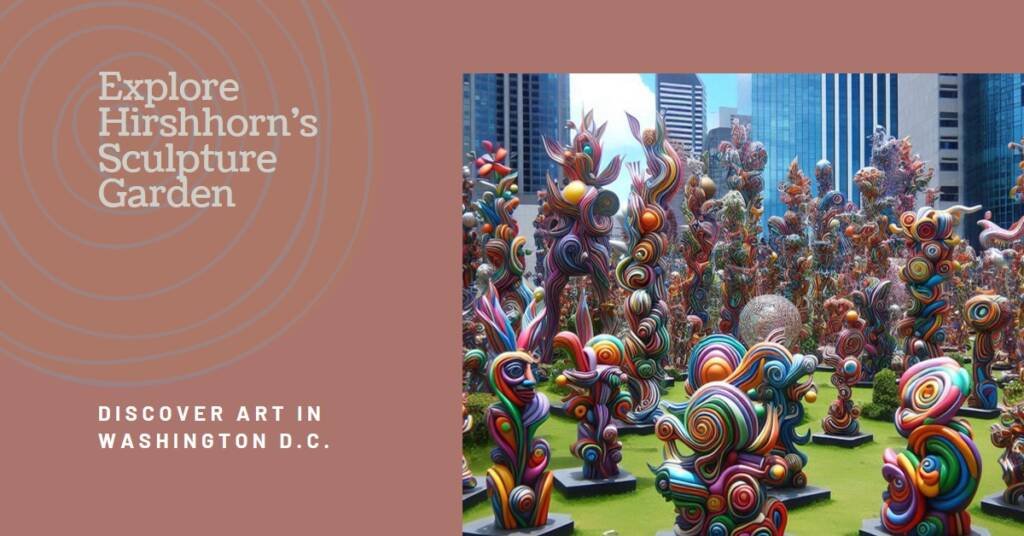
Table of Contents
- Introduction to the Hirshhorn Museum
- The Architecture of the Hirshhorn
- The Sculpture Garden: An Overview
- Featured Sculptures and Artists
- Visitor Experience and Accessibility
- Seasonal Events and Exhibitions
- Connecting Art and Community
- The Hirshhorn in a Global Context
- Conclusion: The Lasting Impact of the Hirshhorn
Introduction to the Hirshhorn Museum
The Hirshhorn Museum and Sculpture Garden stands as a pivotal institution within Washington, D.C.’s vibrant cultural landscape. Established in 1974, the museum is a vital part of the Smithsonian Institution, dedicated to modern and contemporary art. Funded by a substantial endowment from philanthropist Joseph Hirshhorn, the museum showcases an impressive collection that spans several decades and artistic movements, making it a significant destination for art enthusiasts and casual visitors alike.
The museum’s primary mission is to encourage an understanding of and appreciation for modern art. It features works by some of the most celebrated artists, including Henri Matisse, Pablo Picasso, and Yayoi Kusama, among others. With over 12,000 works in its collection, the Hirshhorn serves as a vital resource for those seeking to explore various artistic styles, concepts, and historical contexts. This focus on modern and contemporary art reflects a commitment not only to the artistic heritage of the 20th century but also to the evolving dialogue within the art community today.
Architecturally, the Hirshhorn Museum itself is a masterful embodiment of modern design. Renowned architect Gordon Bunshaft of Skidmore, Owings & Merrill designed the building, introducing a cylindrical structure that harmoniously integrates with its surroundings. The museum’s unique shape and minimalist aesthetic provide a stunning contrast to the more classical structures prevalent in Washington D.C. Furthermore, the surrounding sculpture garden offers an engaging outdoor experience, featuring a rich assortment of sculptures by various artists. Together, the museum and its garden create an inviting atmosphere that encourages exploration and reflection, making the Hirshhorn a truly remarkable gem in the heart of the nation’s capital.
The Architecture of the Hirshhorn
The Hirshhorn Museum, established in 1974, is renowned not only for its impressive collection of modern and contemporary art but also for its distinctive architectural design. The museum’s cylindrical structure, conceived by architect Gordon Bunshaft, sets it apart in Washington, D.C.’s architectural landscape. The choice of this unique shape was deliberate, aimed at creating a harmonious relationship between the building, the artwork it houses, and the surrounding landscape of the sculpture garden.
Bunshaft’s design integrates both form and function, with the circular layout allowing for a seamless viewing experience. Visitors can easily navigate through the galleries, each designed to optimize natural light while ensuring that the exhibited art remains the focal point. The curvature of the building’s exterior softens the starkness often associated with modern architecture, making it inviting and approachable. This design feature not only encourages exploration but also fosters a sense of intimacy between the viewer and the art.
Additionally, the Hirshhorn Museum is surrounded by a beautifully landscaped sculpture garden that extends the architectural themes into the outdoors. The relationship between the museum and its garden allows visitors to appreciate the artwork in a natural setting, enhancing the overall experience. The interplay of sculptures within the garden complements the museum’s architecture, creating a cohesive environment where art and nature coexist. This thoughtful integration makes the Hirshhorn Museum not merely a storage space for art but an essential part of the art viewing experience.
In conclusion, the architecture of the Hirshhorn Museum reflects a deep understanding of the relationship between art, space, and environment. Its cylindrical design by Gordon Bunshaft not only serves as a functional exhibition space but also elevates the art experience within the sculpture garden, allowing visitors to appreciate the works in a visually engaging and thought-provoking context.
The Sculpture Garden: An Overview
The Hirshhorn Museum’s Sculpture Garden is an integral aspect of its appeal, marked by an impressive collection of large-scale works set amidst a landscape artfully designed to enhance the visitor experience. This enchanting outdoor venue spans over two acres and features both contemporary and modern sculptures, reflecting the rich history and evolution of artistic expression. Each piece within this curated garden is thoughtfully positioned, allowing for a dialogue between art and nature.
The layout of the garden is intentionally designed, incorporating various walking paths and open spaces that guide visitors through the exhibition. The arrangement invites an immersive experience, encouraging individuals to engage with the artwork from multiple viewpoints. Visitors can explore both the intimate corners of the garden, where smaller works reside, and expansive lawns showcasing larger installations, creating a varied experience for all who wander through. This thoughtful design not only promotes interaction with the art but also fosters moments of reflection amidst the vibrant surroundings.
Interplay between sculpture and nature is a hallmark of the Hirshhorn’s Sculpture Garden. Natural elements such as trees, shrubs, and seasonal flowers are harmoniously integrated with the artistic installations, creating a serene environment that enhances the visual and sensory impact of the sculptures. The changing seasons further contribute to this dynamic experience, as blossoms in spring provide a stark contrast to the winter landscape, presenting unique perspectives of the sculptures throughout the year. This interaction reveals how the art exists in relation to the elements of nature, encouraging visitors to contemplate the relationship between artistic expression and the natural world.
Ultimately, the Sculpture Garden at the Hirshhorn Museum serves as a serene retreat for visitors, fostering contemplation and a deeper appreciation for the art it houses. With its thoughtful design, captivating artworks, and beautiful natural surroundings, this garden invites all to explore and engage with the world of sculpture in an unhurried fashion.
Featured Sculptures and Artists
The Hirshhorn Museum’s sculpture garden is home to a remarkable collection of works that reflect contemporary themes and artistic innovation. Among the notable sculptures, one can find works by esteemed artists such as Alexander Calder, Jeff Koons, and Jean Dubuffet. Each artist brings a unique perspective, contributing to the enrichment of the garden’s atmosphere.
One of the standout pieces is Calder’s majestic “Yellow Ellipse,” an exemplary showcase of his expertise in kinetic art. Known for integrating movement into his sculptures, Calder’s work invites viewers to contemplate the relationship between form and space. The vibrant color combined with its playful design allows the sculpture to resonate with visitors, symbolizing joy and spontaneity within the urban landscape.
Another significant work is “Balloon Dog” by Jeff Koons, which encapsulates the juxtaposition of common objects with artistic grandeur. Koons creates a profound commentary on consumerism and the transient nature of joy through this oversized, shiny sculpture. Its reflective surface captures the surrounding environment, engaging viewers and compelling them to consider the connectivity of art, society, and personal experience.
Jean Dubuffet’s “Group of Four Trees” embodies a powerful departure from traditional artistic forms, embracing raw, unrefined aesthetics. By employing unconventional materials, Dubuffet explored themes of identity, and nature, and sought to challenge the norms of the art world. His creative process often involved a deep investigation of how one’s environment shapes perception, making this piece a critical example of his philosophy.
Overall, the featured sculptures and their artists in the Hirshhorn Museum’s sculpture garden serve as a testament to contemporary artistic vision, reflecting broader cultural narratives while inviting engagement and interpretation from its audience.
Visitor Experience and Accessibility
The Hirshhorn Museum and Sculpture Garden, located in the heart of Washington, D.C., offers a rich and immersive experience for art enthusiasts and casual visitors alike. Admission to the museum is free, allowing unrestricted access to a remarkable collection of contemporary art and sculptures. Visitors can take advantage of various tours designed to enhance their understanding of the artworks on display. Guided tours are often available, led by knowledgeable docents who provide engaging insights into the museum’s diverse collections.
One of the standout features of the Hirshhorn is its commitment to accessibility. The museum is designed with inclusivity in mind, ensuring that all visitors can navigate the spaces comfortably. Wheelchair accessibility is provided throughout the interior and exterior areas, including restrooms and entrances. For those with hearing impairments, the museum offers assistive listening devices during guided tours. Additionally, tactile tours and touchable objects may also be available, fostering a more interactive experience for individuals with visual impairments.
The Hirshhorn Museum is also home to a range of visitor amenities aimed at enhancing the overall experience. A museum shop offers a variety of art-related merchandise, while the café provides an inviting space to relax and enjoy a meal or a beverage amid artistic surroundings. Educational programs are regularly organized, ranging from workshops for children to lectures by renowned artists, adding depth to the visitor experience.
Furthermore, the museum regularly hosts special events, such as exhibitions and installations that coincide with significant dates in the art calendar. These activities are often designed to engage the community and provide a platform for discussions surrounding contemporary art. Whether you are visiting for the first time or returning as a seasoned patron, the Hirshhorn Museum promises an enriching encounter with art in a beautiful, accessible setting.
Seasonal Events and Exhibitions
The Hirshhorn Museum is dedicated to maintaining a dynamic visitor experience through its carefully curated seasonal events and temporary exhibitions. These events not only enhance the museum’s permanent collection but also introduce fresh interpretations of contemporary art, reflecting current trends and movements within the artistic community. Whether one is a first-time visitor or a seasoned patron, there is always something new and engaging to discover at this renowned institution.
A significant aspect of the Hirshhorn’s programming is its temporary exhibitions, which often showcase works from both established and emerging artists. These exhibitions provide a platform for innovative approaches to contemporary art, offering visitors fresh perspectives on the themes and mediums that dominate today’s art world. For instance, past exhibitions have explored diverse topics ranging from social justice to environmental issues, effectively engaging audiences in thought-provoking dialogues. Such events are designed not only to attract visitors but also to enrich their understanding of contemporary art practice.
The museum also hosts seasonal events, including lectures, workshops, and guided tours that complement the exhibitions. These activities are tailored to foster deeper engagement by encouraging participants to interact with the art and learn from experts in the field. Additionally, these events often allow for collaborative partnerships with local artists and organizations, further enriching the community’s connection to the Hirshhorn. By offering dynamic and evolving programming, the Hirshhorn Museum remains a beacon of contemporary artistic expression in Washington, D.C., continually renewing its appeal for audiences of all ages.
Connecting Art and Community
The Hirshhorn Museum plays a pivotal role in the cultural fabric of Washington, D.C., by serving as a vital connection between art and the local community. With its commitment to making contemporary art accessible, the museum has initiated a variety of outreach programs designed to engage diverse audiences. These initiatives aim to foster appreciation for art while promoting inclusivity within the community.
One of the key components of the Hirshhorn’s community engagement strategy is its collaboration with local artists and organizations. These partnerships not only support artists but also encourage dialogue between the museum and the community it serves. Through workshops, exhibitions, and collaborative projects, the museum creates a platform where local voices can be heard, thus enriching the artistic landscape of the area.
In addition to artist collaborations, the Hirshhorn Museum undertakes various educational programs that cater to people of all ages. By conducting tours, lectures, and school programs, the museum strives to enhance art education and provide opportunities for individuals to explore their creativity. These efforts are particularly significant for underserved communities, ensuring that access to art and cultural experiences is equitable and far-reaching.
The Hirshhorn also recognizes the importance of adapting its programs to reflect the needs of the community. By actively seeking feedback and involving community members in the development of initiatives, the museum ensures that its offerings remain relevant and resonant. This interaction creates a dynamic environment where art enthusiasts can connect with contemporary works while fostering a sense of belonging and ownership.
Overall, the Hirshhorn Museum exemplifies a committed approach to connecting art with the community, prioritizing accessibility and engagement. Through ongoing outreach and collaboration, it fosters a deeper appreciation for art, ultimately enhancing the cultural vibrancy of Washington, D.C.
The Hirshhorn in a Global Context
The Hirshhorn Museum and Sculpture Garden, a significant cultural institution located in Washington, D.C., plays a pivotal role in the global contemporary art landscape. Established in 1974, the museum was designed by the renowned architect Gordon Bunshaft and has since become a focal point for modern art and sculpture. Its extensive collection features an impressive array of over 12,000 works, showcasing influential artists from various regions and backgrounds. This diversity not only emphasizes the museum’s commitment to presenting contemporary art but also aligns it with other major institutions worldwide.
In a global context, the Hirshhorn’s exhibitions invite both national and international audiences to engage with contemporary art practices. By featuring artists like Yayoi Kusama, Ai Weiwei, and Jeff Koons, the museum fosters dialogues that transcend cultural boundaries. These exhibitions provide a platform that connects local artistic expressions with global narratives, encouraging a broader understanding of contemporary issues reflected in art. The museum’s programming often draws connections to international art movements, positioning it as a vital participant in the ongoing discussion surrounding cultural representation and artistic innovation.


Conclusion: The Lasting Impact of the Hirshhorn
In reflecting on the significance of the Hirshhorn Museum and its remarkable sculpture garden, it is evident that this cultural institution is essential to Washington D.C.’s artistic landscape. The Hirshhorn stands out not only for its impressive collection of modern and contemporary art but also for its commitment to accessibility and public engagement. By offering free admission, the museum ensures that art is available to a wider audience, thus enriching the community’s cultural fabric.
The sculpture garden, with its thoughtfully displayed works, provides an immersive experience that encourages visitors to engage with art in a serene outdoor setting. This space allows for the appreciation of large-scale sculptures, which often inspire dialogue and reflection among visitors. Whether viewed in isolation or as part of a curated exhibition, each piece in the garden contributes to a greater understanding of contemporary artistic practices and ideas.
Notably, the Hirshhorn’s role extends beyond being a mere repository of art. It actively fosters an appreciation for modern artistic expressions through diverse educational programs and exhibitions. These initiatives not only highlight contemporary artists but also invite both locals and tourists to explore the evolving narrative of art in society. By showcasing innovative works, the Hirshhorn Museum stimulates critical thought about the world we live in and encourages discourse around pressing social issues.
Ultimately, the Hirshhorn Museum and its sculpture garden serve as a testament to the power of art in shaping and enhancing urban life. Its ongoing efforts to promote engagement with modern and contemporary art underscore its status as a pivotal destination for anyone seeking to understand the complexities of contemporary culture. Whether one is a long-time art enthusiast or a newcomer exploring the world of modernism, the Hirshhorn undoubtedly leaves a lasting impact on those who visit.



